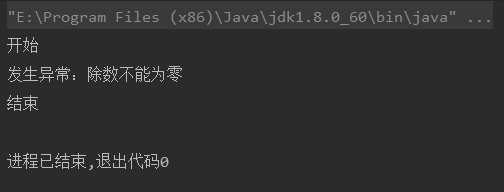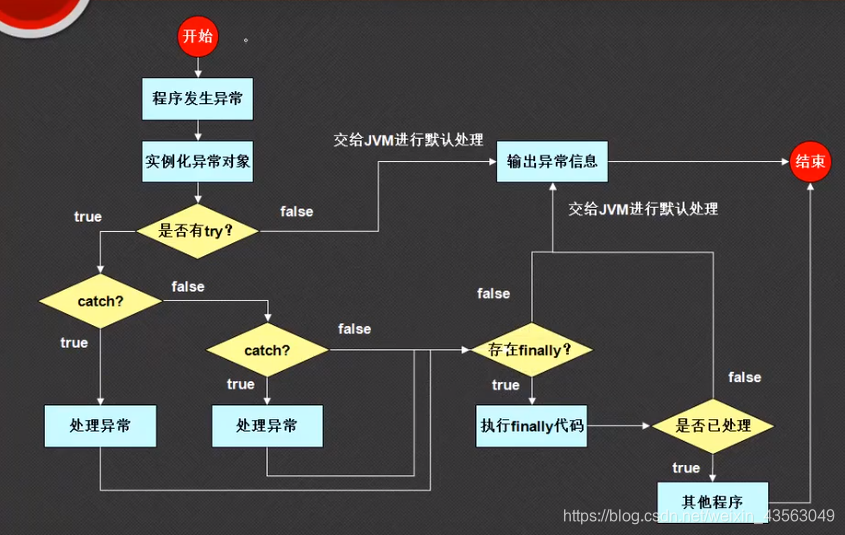一,异常:是导致程序中断执行的指令流,一旦产生异常之后,产生异常及以后的语句都不再执行,自动结束程序的执行。
二,处理产生的异常
- try…catch…finally
- try…catch
- try…finally
- 捕获异常:try{可能产生异常的代码},捕获产生异常语句后直接跳转catch,异常后的语句不再执行
- 处理异常:catch(异常类型 异常对象){处理异常},catch可以有多个
- finally{不管是否产生异常都会执行}
package 异常;
public class ExceptionDemo {
public static void main(String[] args) {
try {
System.out.println("开始");
int result = 10/0;
System.out.println(result);
}catch (Exception e)
{
// e.printStackTrace();
System.out.println("发生异常:除数不能为零");
}finally
{
System.out.println("结束");
}
}
}

几点说明:
- Exception类是所有异常类的父类,因此在不知道会出现什么异常的时候,catch中统一使用Exception(向上转型)处理,
- 多个catch捕获异常时,捕获范围大的异常放在捕获范围小的后面,否则程序出现错误
- 异常和错误的区别是:异常能被程序本身可以处理,错误是无法处理
- Exception(异常)分两大类:运行时异常和非运行时异常(编译异常)。程序中应当尽可能去处理这些异常。
- 运行时异常:都是RuntimeException类及其子类异常,如NullPointerException(空指针异常)、IndexOutOfBoundsException(下标越界异常)等,这些异常是不检查异常,程序中可以选择捕获处理,也可以不处理。这些异常一般是由程序逻辑错误引起的,程序应该从逻辑角度尽可能避免这类异常的发生。运行时异常的特点是Java编译器不会检查它,也就是说,当程序中可能出现这类异常,即使没有用try-catch语句捕获它,也没有用throws子句声明抛出它,也会编译通过。
- 非运行时异常 (编译异常):是RuntimeException以外的异常,类型上都属于Exception类及其子类。从程序语法角度讲是必须进行处理的异常,如果不处理,程序就不能编译通过。如IOException、SQLException等以及用户自定义的Exception异常,一般情况下不自定义检查异常。
附:程序异常处理流程图:

三,抛出异常:throws主要用于方法的声明上,表示方法中产生的异常交给调用处处理,但不一定会产生异常,表示一种可能性,不管是否产生异常都要用try…catch。throw,表示抛出一个异常对象,表示一种动作。
- throws
package 异常;
public class ExceptionDemo {
public static void main(String[] args) {
try {
System.out.println("开始");
int x = 10;
int y = 0;
div(x, y);
} catch (Exception e) {
System.out.println("发生异常:除数不能为零");
} finally
{
System.out.println("结束");
}
}
public static void div(int x, int y) throws Exception {
System.out.println(x / y);
}
}

- throw
package 异常;
public class ExceptionDemo {
public static void main(String[] args) {
String s= null;
if(s==null)
{//抛出空指针异常
throw new NullPointerException();
}
else
{
System.out.println(s);
}
}
}
- throw and throws---->异常处理的标准化
package 异常;
public class ExceptionDemo {
public static void main(String[] args) {
try {
int x = 10;
int y = 0;
System.out.println(div(x, y));
} catch (Exception e) {
System.out.println("发生异常:除数不能为零");
}
}
public static int div(int x, int y) throws Exception {
int result = 0;
try {
System.out.println("开始");
result = x/y;
}catch (Exception e)
{
throw e;//将产生的异常抛出,再由throws抛到调用处处理
}finally
{
System.out.println("结束");
}
return result;
}
}
四,RuntimeException类:运行时异常类(NullPointerException,ArithmeticException,ClassCastException)。程序在编译时,不会强制性要求用户处理,如果产生了异常,将交给JVM默认处理。RuntimeException的子类可以可以根据用户需求选择性处理,Exception类型的异常必须处理。
五,自定义异常:
package 异常;
class selfException extends Exception
{
public selfException(String ex)
{
super(ex);
}
}
public class ExceptionDemo {
public static void main(String[] args) {
try {
int num = 10;
if(num>=10)
{
throw new selfException("自定义异常");
}
}catch (Exception e)
{
e.printStackTrace();
}
}
}























 197
197











 被折叠的 条评论
为什么被折叠?
被折叠的 条评论
为什么被折叠?








